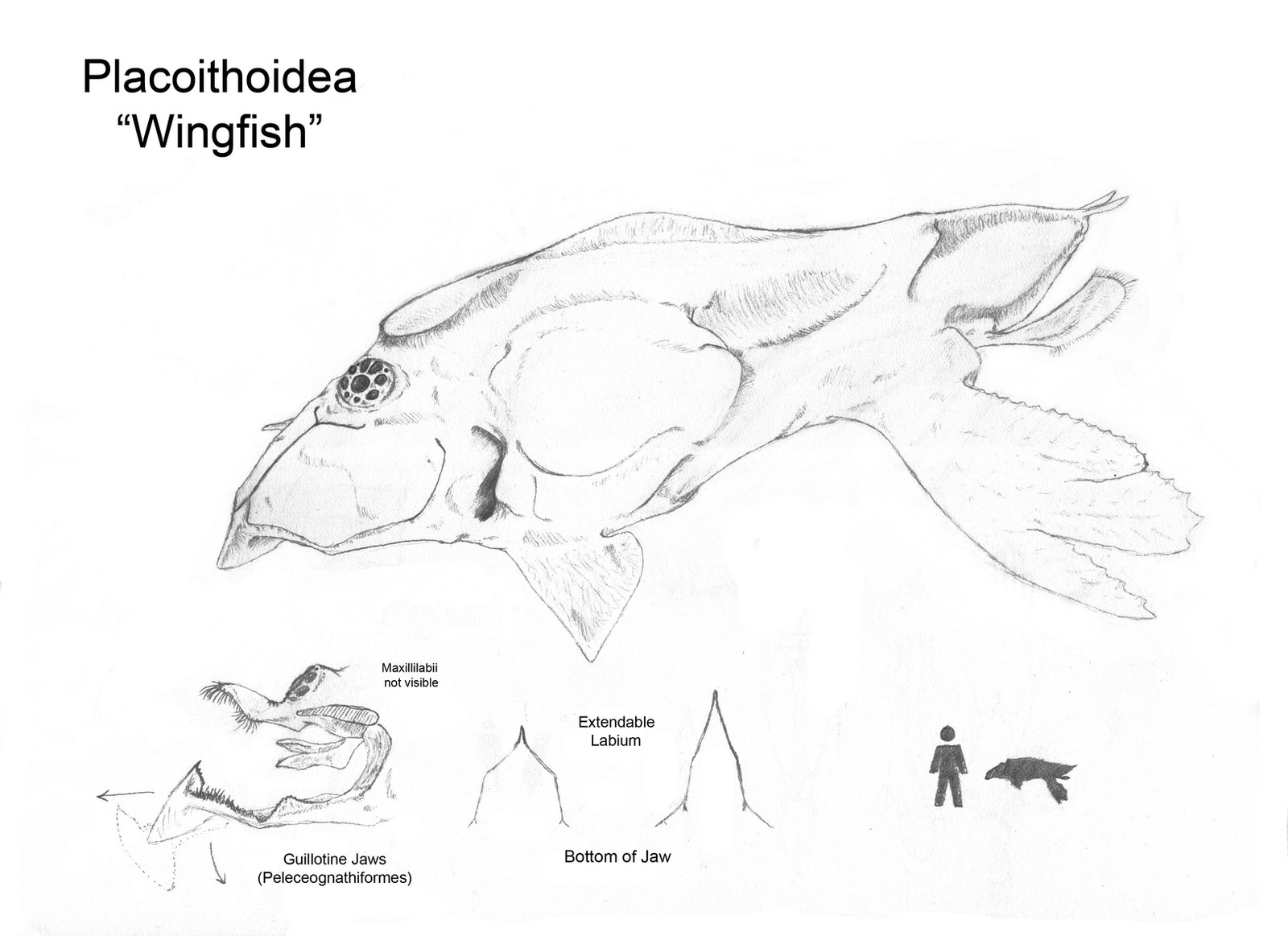HOME | DD
 Onironus — Erytheian 'Fish'
Onironus — Erytheian 'Fish'

Published: 2011-05-30 19:30:57 +0000 UTC; Views: 4004; Favourites: 55; Downloads: 0
Redirect to original
Description
As always, even on earth, any kind of organism that swims can be labelled as a fish.This specific clade of aquatic Erytheian organisms, the placoithoideans, inhabit the lakes, rivers and streams of Erytheia, and are the most abundant of the aquatic loricates.
Colloquially, they are known as wingfish, for obvious reasons. Their rear appendages, which are structurally reinforced with proteinaceous shafts, work similar to the legs of some earth diving birds, like grebes. The three apparent digits on the flipper spread apart on the recovery stroke to reduce drag.
The jaw structure is representative of a specific group of placoithoideans, called the peleceognathiformes, or guillotine jaws. The jaw itself is composed of various elements derived from valves, and projections of the shell and rostrum from the primitive antliavasans, an ancestral group outside the placoicthoideans.
The topmost visible flaps on the jaw are called the maxillilabii (sing. maxillilabium) and in peleceognathiformes, serve to direct and manipulate prey in toward the mouth with stiff, hooked hairs on the inside surface. The lower portion of the jaw is called the labium, and is extendable. At the tip of the labium is a toothed, wedge-shaped structure called the dolabra. Above the labium, coming off the rostrum is the muscular labrum, which often bristles with stiff, hooked hairs, and also serves to manipulate and hold food.
When prey has been sighted by the wingfish, muscles at the base of the labium will contract inward and shoot out the labium, which angles the dolabra downward. Pharyngeal widening, assisted by the maxillilabii and labrum induces negative pressure toward the mouth and pulls the prey inward. Once the dolabra is under the prey, another set of muscles widen the edges of the labium, and the dolabra snaps upward and back toward the mouth, catching the outside edge of the prey and grappling it inward into the grip of the maxillilabii. A pair of bristled tongues shoves the prey into the pharynx where it will be masticated by a radula-like structure before entering the crop.
All placoithoideans remove oxygen from the water by counter-current gas exchange, just like earth vertebrate fish. Because Erytheia has a higher oxygen content in the atmosphere and a greater atmosphereic pressure, there tends to be a larger amount of oxygen dissolved in the water. However, since Erytheia's average atmospheric temperature is much higher than Earth's, this tends to be balanced out, and leaves aquatic O2 concentrations roughly equivalent to tropical Earth's. As a result, much of Erytheia's aquatic life is comparable in size to Earth's, except where superior respiration efficiency is present or temperatures are much lower, possibly at abyssal depths.
All that is known of Erytheia's aquatic lifeforms is from specimens caught in nets placed in the muddy waters of major rivers or photographic surveys of lakes and streams. Deep-water aquatic life is unknown and will probably remain so for the forseeable future.
Marine life is even more baffling, since it is unlikely, though unproven, if large loricates, ctenopods, or other complex lifeforms can live below the surface of the highly saline seas.
Related content
Comments: 14

but dolphins cannot be called fish! 
👍: 0 ⏩: 0

Haha! Well, you're right about that. I was thinking more along the lines of "jellyfish", "starfish", and "shellfish" specifically when I said that (even though nowadays the proper terms are "sea jellies", "sea stars" and "molluscs"--we are seeing the error of our nomenclatural ways). But "fish" is a broad term anyways, since sharks are so-called and in an entirely different class than bony fish. And then there's hagfish . . . The list goes on.
Yes, the more primitive loricates do look like cyclops. This is due to the placement of the light-sensing organs in the earliest, radial loricates. More derived forms tend to have wider spread eyes for a better angle of vision.
👍: 0 ⏩: 1

Yes I know, but this was so tempting to make a joke...
👍: 0 ⏩: 1

I'm surprised I didn't think of that sooner too. I mean, I said "pretty much anything that swims". . .
👍: 0 ⏩: 1

I do have a couple scattered pieces of paper with rough outlines of Erytheia on them. However, up until recently I have been unable to really think seriously about making a map. Now that you bring it up though, I had been wanting to do one, and it slipped my mind. I think I will make that one of the things high up on my to-do list for Erytheia, even if it's a rough representation of coastlines or something.
Thanks for your interest, and for the fave as well.
👍: 0 ⏩: 0

Amazing. I love the design of it's head and the shape of its body.
👍: 0 ⏩: 1

Yeah, I think I tried to put it in, but I couldn't get the perspective to work, so I reasoned that it was positioned just so to make the fin hidden. A bit of a cop-out, I know.
👍: 0 ⏩: 0

I love this, especially the circular cluster of eyes, but it's weird that the creature's other hind fin isn't visible.
👍: 0 ⏩: 0


























